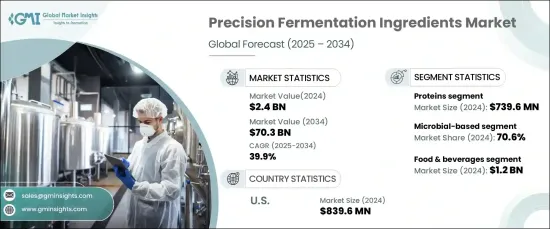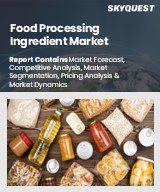
|
시장보고서
상품코드
1667106
정밀 발효 성분 시장 기회, 성장 촉진 요인, 산업 동향 분석, 예측(2025-2034년)Precision Fermentation Ingredients Market Opportunity, Growth Drivers, Industry Trend Analysis, and Forecast 2025 - 2034 |
||||||
세계의 정밀 발효 성분 시장은 2024년에 24억 달러로 평가되었고, 2025년부터 2034년에 걸쳐 39.9% 연평균 복합 성장률(CAGR)을 나타낼 것으로 예측되고 있습니다.
이 급성장의 주요 요인은 식품, 음료, 의약품과 같은 업계의 진화하는 수요에 부응하는 지속 가능하고 고품질의 원료로의 전환입니다. 소비자의 환경 의식이 높아져 식물 유래나 미생물 유래의 제품을 우선하는 경향이 강해지고 있는 가운데, 산업계는 해결책으로서 정밀 발효를 채용하고 있습니다.

환경문제에 대한 의식이 높아지고, 보다 윤리적인 식품원에 대한 요구가 증가하며, 보다 지속가능한 생산방법으로의 전환은 모두 시장의 급속한 확대에 기여하고 있습니다. 게다가 바이오테크놀러지, 특히 미생물주공학에 있어서 끊임없는 기술 혁신이 정밀 발효를 보다 이용하기 쉽고 비용 효율적인 것으로 하는 효율화를 추진하여 다양한 부문에 광범위한 채용을 가능하게 하고 있습니다. 이러한 추세로 인해 정밀 발효는 단순한 추세가 아니며 산업계가 원료를 조달하는 방법의 근본적인 전환이되었습니다.
| 시장 범위 | |
|---|---|
| 시작 연도 | 2024년 |
| 예측 연도 | 2025년-2034년 |
| 시작 금액 | 24억 달러 |
| 예측 금액 | 703억 달러 |
| CAGR | 39.9% |
정밀 발효 시장의 단백질분야는 2024년 7억 3,960만 달러로 평가되었으며, 예측기간 동안 CAGR 37.5%로 성장할 것으로 예상됩니다. 지속가능성과 영양가를 뒷받침하는 대체 단백질에 대한 수요 증가는 이 성장의 주요 요인입니다. 정밀 발효는 맛과 기능성에서 기존의 단백질을 재현한 동물성 미사용 단백질을 생산하는데 있어서 매우 중요한 역할을 하고 있으며, 채식주의자나 건강 지향의 소비자에게도 매력적인 것이 되고 있습니다. 미생물 주식 공학의 혁신은 생산 효율을 향상시키고 비용을 낮추고 식품, 음료 및 의약품에 사용되는 이러한 단백질의 다양성을 향상시킵니다. 이로 인해 이용가능한 단백질 솔루션의 다양화와 확대를 위한 R&D 투자가 현저하게 증가하고 시장 성장이 더욱 가속화되고 있습니다.
2024년에는 미생물 기반 부문이 정밀 발효 성분 시장을 독점하여 70.6%의 점유율을 차지했습니다. 이러한 이점은 지속가능하고 다재다능한 생산방법에 대한 요구가 증가함에 기인합니다. 미생물 발효는 건강 보조 식품에 필수적인 단백질, 효소, 비타민 등 필수 성분을 생산하는 데 필수적입니다. 생명 공학의 급속한 진보는 발효 과정의 끊임없는 개선과 함께 미생물 기반 발효의 저렴한 가격과 확장 성을 높였습니다. 이러한 기술 혁신을 통해 이 기술은 식품, 농업, 의약품 등 폭넓은 산업에 침투하여 지속적인 시장 확대와 신규 용도의 출현을 가져왔습니다.
미국의 정밀 발효 성분 시장은 2024년에는 8억 3,960만 달러로 평가되었고, 2034년까지 CAGR은 39.1%로 성장할 것으로 예상되고 있습니다. 이 성장을 견인하는 중요한 동향은 식물 유래 발효 원료에 대한 선호 증가입니다. 미국 소비자들은 건강과 윤리 지향을 강화하고 지속가능하고 친환경적인 가치관에 맞는 제품을 선호합니다. 이 변화는 특히 식품 및 음료 업계에서 두드러지며, 기업은 보다 건강하고 지속 가능한 선택을 요구하는 소비자 수요에 부응하기 위해 식물 유래의 발효 원료를 제품에 도입하고 있습니다.
목차
제1장 조사 방법과 조사 범위
- 시장 범위와 정의
- 기본 추정과 계산
- 예측 계산
- 데이터 소스
- 1차
- 2차
- 유료소스
- 공적소스
제2장 주요 요약
제3장 업계 인사이트
- 업계 생태계 분석
- 밸류체인에 영향을 주는 요인
- 이익률 분석
- 변혁
- 장래 전망
- 제조업체
- 유통업체
- 공급자의 상황
- 이익률 분석
- 주요 뉴스
- 규제 상황
- 영향요인
- 성장 촉진요인
- 지속가능하고 윤리적으로 조달된 원료에 대한 소비자 수요 증가
- 생명공학과 발효기술의 진보
- 정밀 발효 성분과 관련된 건강 효과에 대한 의식 증가
- 업계의 잠재적 리스크 및 과제
- 규제상의 과제
- 승인 과정에서의 불확실성
- 성장 촉진요인
- 성장 가능성 분석
- Porter's Five Forces 분석
- PESTEL 분석
제4장 경쟁 구도
- 소개
- 기업의 시장 점유율 분석
- 경쟁 포지셔닝 매트릭스
- 전략 전망 매트릭스
제5장 시장 추정 및 예측 : 제품 유형별, 2021년-2034년
- 주요 동향
- 효모 베이스 성분
- 효소
- 항체
- 단백질
제6장 시장 추정 및 예측 :성분 소스별, 2021년-2034년
- 주요 동향
- 미생물 유래
- 식물 유래
- 동물 유래
제7장 시장 추정 및 예측 : 용도별, 2021년-2034년
- 주요 동향
- 음식
- 의약품
- 농업
- 산업용도
제8장 시장 추정 및 예측 : 지역별, 2021년-2034년
- 주요 동향
- 북미
- 미국
- 캐나다
- 유럽
- 영국
- 독일
- 프랑스
- 이탈리아
- 스페인
- 러시아
- 아시아태평양
- 중국
- 인도
- 일본
- 한국
- 호주
- 라틴아메리카
- 브라질
- 멕시코
- 중동 및 아프리카
- 남아프리카
- 사우디아라비아
- 아랍에미리트(UAE)
제9장 기업 프로파일
- Amyris
- BlueNalu
- Brightseed
- Biomilq
- Bolt Threads
- Ginkgo Bioworks
- Clara Foods
- Conagen
- Enzymaster
- Impossible Foods
- KnipBio
- Lygos
- Motif FoodWorks
- Novozymes
- Perfect Day
The Global Precision Fermentation Ingredients Market, valued at USD 2.4 billion in 2024, is set to exhibit a CAGR of 39.9% from 2025 to 2034. This surge is primarily fueled by a shift toward sustainable, high-quality ingredients that cater to the evolving demands of industries like food, beverages, and pharmaceuticals. As consumers become more eco-conscious and increasingly prioritize plant-based and microbe-derived products, industries are embracing precision fermentation as a solution.

The growing awareness of environmental concerns, the desire for more ethical food sources, and the shift toward more sustainable production methods are all contributing to the market's rapid expansion. Moreover, the continuous innovation in biotechnology, particularly in microbial strain engineering, is driving efficiencies that make precision fermentation more accessible and cost-effective, enabling its widespread adoption across various sectors. These factors make precision fermentation not just a trend but a fundamental shift in how industries are sourcing ingredients.
| Market Scope | |
|---|---|
| Start Year | 2024 |
| Forecast Year | 2025-2034 |
| Start Value | $2.4 billion |
| Forecast Value | $70.3 billion |
| CAGR | 39.9% |
The protein segment of the precision fermentation market was valued at USD 739.6 million in 2024 and is expected to grow at an impressive CAGR of 37.5% during the forecast period. The rising demand for alternative proteins, driven by their sustainability and nutritional value, is a key factor behind this growth. Precision fermentation plays a pivotal role in producing animal-free proteins that replicate traditional proteins in taste and functionality, making them appealing to vegan and health-conscious consumers alike. Innovations in microbial strain engineering have improved production efficiency, lowered costs, and enhanced the versatility of these proteins for use in food, beverages, and pharmaceuticals. This has led to a notable increase in R&D investments to diversify and expand the range of protein solutions available, which is further accelerating the growth of the market.
In 2024, the microbial-based segment dominated the precision fermentation ingredients market, holding a 70.6% share. This dominance can be attributed to the growing need for sustainable and versatile production methods. Microbial fermentation has become a cornerstone for producing essential ingredients, including proteins, enzymes, and vitamins, which are integral to health supplements. The rapid advancements in biotechnology, alongside continuous improvements in fermentation processes, have enhanced the affordability and scalability of microbial-based fermentation. These innovations have allowed the technique to penetrate a wide range of industries, such as food, agriculture, and pharmaceuticals, resulting in continuous market expansion and the emergence of novel applications.
The U.S. precision fermentation ingredients market, valued at USD 839.6 million in 2024, is expected to grow at a CAGR of 39.1% through 2034. A significant trend driving this growth is the increasing preference for plant-based fermentation ingredients. U.S. consumers are becoming more health-conscious and ethically driven, favoring products that align with sustainable and eco-friendly values. This shift is particularly evident in the food and beverage industries, where companies are incorporating plant-based, fermentation-derived ingredients into their products to meet consumer demand for healthier, more sustainable options.
Table of Contents
Chapter 1 Methodology & Scope
- 1.1 Market scope & definitions
- 1.2 Base estimates & calculations
- 1.3 Forecast calculations
- 1.4 Data sources
- 1.4.1 Primary
- 1.4.2 Secondary
- 1.4.2.1 Paid sources
- 1.4.2.2 Public sources
Chapter 2 Executive Summary
- 2.1 Industry synopsis, 2021-2034
Chapter 3 Industry Insights
- 3.1 Industry ecosystem analysis
- 3.1.1 Factor affecting the value chain
- 3.1.2 Profit margin analysis
- 3.1.3 Disruptions
- 3.1.4 Future outlook
- 3.1.5 Manufacturers
- 3.1.6 Distributors
- 3.2 Supplier landscape
- 3.3 Profit margin analysis
- 3.4 Key news & initiatives
- 3.5 Regulatory landscape
- 3.6 Impact forces
- 3.6.1 Growth drivers
- 3.6.1.1 Growing consumer demand for sustainable and ethically sourced ingredients
- 3.6.1.2 Advancements in biotechnology and fermentation techniques
- 3.6.1.3 Increasing awareness of health benefits associated with precision fermentation ingredients
- 3.6.2 Industry pitfalls & challenges
- 3.6.2.1 Regulatory challenges
- 3.6.2.2 Uncertainties in approval processes
- 3.6.1 Growth drivers
- 3.7 Growth potential analysis
- 3.8 Porter’s analysis
- 3.9 PESTEL analysis
Chapter 4 Competitive Landscape, 2024
- 4.1 Introduction
- 4.2 Company market share analysis
- 4.3 Competitive positioning matrix
- 4.4 Strategic outlook matrix
Chapter 5 Market Estimates & Forecast, By Product Type, 2021-2034 (USD Billion) (Kilo Tons)
- 5.1 Key trends
- 5.2 Yeast-based ingredients
- 5.3 Enzymes
- 5.4 Anti-bodies
- 5.5 Proteins
Chapter 6 Market Estimates & Forecast, By Ingredient Source, 2021-2034 (USD Billion) (Kilo Tons)
- 6.1 Key trends
- 6.2 Microbial-based
- 6.3 Plant-based
- 6.4 Animal-based
Chapter 7 Market Estimates & Forecast, By Application, 2021-2034 (USD Billion) (Kilo Tons)
- 7.1 Key trends
- 7.2 Food & beverages
- 7.3 Pharmaceuticals
- 7.4 Agriculture
- 7.5 Industrial applications
Chapter 8 Market Estimates & Forecast, By Region, 2021-2034 (USD Billion) (Kilo Tons)
- 8.1 Key trends
- 8.2 North America
- 8.2.1 U.S.
- 8.2.2 Canada
- 8.3 Europe
- 8.3.1 UK
- 8.3.2 Germany
- 8.3.3 France
- 8.3.4 Italy
- 8.3.5 Spain
- 8.3.6 Russia
- 8.4 Asia Pacific
- 8.4.1 China
- 8.4.2 India
- 8.4.3 Japan
- 8.4.4 South Korea
- 8.4.5 Australia
- 8.5 Latin America
- 8.5.1 Brazil
- 8.5.2 Mexico
- 8.6 MEA
- 8.6.1 South Africa
- 8.6.2 Saudi Arabia
- 8.6.3 UAE
Chapter 9 Company Profiles
- 9.1 Amyris
- 9.2 BlueNalu
- 9.3 Brightseed
- 9.4 Biomilq
- 9.5 Bolt Threads
- 9.6 Ginkgo Bioworks
- 9.7 Clara Foods
- 9.8 Conagen
- 9.9 Enzymaster
- 9.10 Impossible Foods
- 9.11 KnipBio
- 9.12 Lygos
- 9.13 Motif FoodWorks
- 9.14 Novozymes
- 9.15 Perfect Day



















